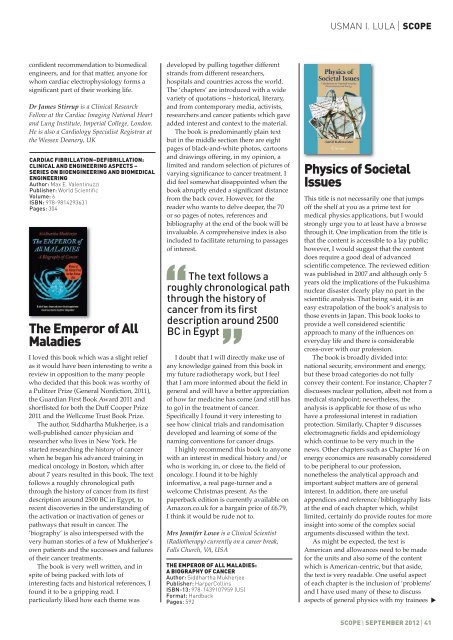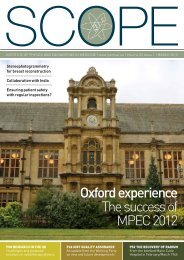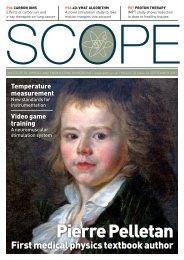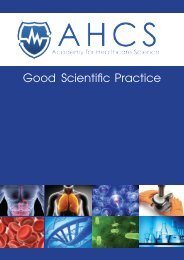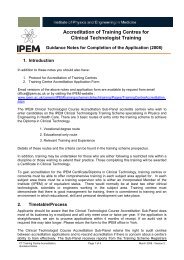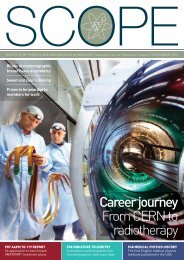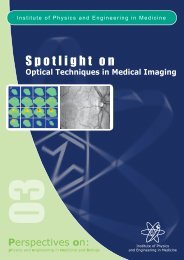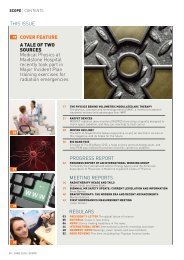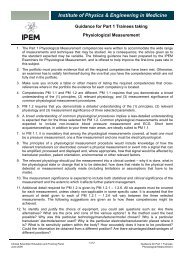Experience the Elekta Differ - Institute of Physics and Engineering in ...
Experience the Elekta Differ - Institute of Physics and Engineering in ...
Experience the Elekta Differ - Institute of Physics and Engineering in ...
You also want an ePaper? Increase the reach of your titles
YUMPU automatically turns print PDFs into web optimized ePapers that Google loves.
confident recommendation to biomedical<br />
eng<strong>in</strong>eers, <strong>and</strong> for that matter, anyone for<br />
whom cardiac electrophysiology forms a<br />
significant part <strong>of</strong> <strong>the</strong>ir work<strong>in</strong>g life.<br />
Dr James Stirrup is a Cl<strong>in</strong>ical Research<br />
Fellow at <strong>the</strong> Cardiac Imag<strong>in</strong>g National Heart<br />
<strong>and</strong> Lung <strong>Institute</strong>, Imperial College, London.<br />
He is also a Cardiology Specialist Registrar at<br />
<strong>the</strong> Wessex Deanery, UK<br />
CARDIAC FIBRILLATION–DEFIBRILLATION:<br />
CLINICAL AND ENGINEERING ASPECTS –<br />
SERIES ON BIOENGINEERING AND BIOMEDICAL<br />
ENGINEERING<br />
Author: Max E. Valent<strong>in</strong>uzzi<br />
Publisher: World Scientific<br />
Volume: 6<br />
ISBN: 978-9814293631<br />
Pages: 304<br />
The Emperor <strong>of</strong> All<br />
Maladies<br />
I loved this book which was a slight relief<br />
as it would have been <strong>in</strong>terest<strong>in</strong>g to write a<br />
review <strong>in</strong> opposition to <strong>the</strong> many people<br />
who decided that this book was worthy <strong>of</strong><br />
a Pulitzer Prize (General Nonfiction, 2011),<br />
<strong>the</strong> Guardian First Book Award 2011 <strong>and</strong><br />
shortlisted for both <strong>the</strong> Duff Cooper Prize<br />
2011 <strong>and</strong> <strong>the</strong> Wellcome Trust Book Prize.<br />
The author, Siddhartha Mukherjee, is a<br />
well-published cancer physician <strong>and</strong><br />
researcher who lives <strong>in</strong> New York. He<br />
started research<strong>in</strong>g <strong>the</strong> history <strong>of</strong> cancer<br />
when he began his advanced tra<strong>in</strong><strong>in</strong>g <strong>in</strong><br />
medical oncology <strong>in</strong> Boston, which after<br />
about 7 years resulted <strong>in</strong> this book. The text<br />
follows a roughly chronological path<br />
through <strong>the</strong> history <strong>of</strong> cancer from its first<br />
description around 2500 BC <strong>in</strong> Egypt, to<br />
recent discoveries <strong>in</strong> <strong>the</strong> underst<strong>and</strong><strong>in</strong>g <strong>of</strong><br />
<strong>the</strong> activation or <strong>in</strong>activation <strong>of</strong> genes or<br />
pathways that result <strong>in</strong> cancer. The<br />
‘biography’ is also <strong>in</strong>terspersed with <strong>the</strong><br />
very human stories <strong>of</strong> a few <strong>of</strong> Mukherjee’s<br />
own patients <strong>and</strong> <strong>the</strong> successes <strong>and</strong> failures<br />
<strong>of</strong> <strong>the</strong>ir cancer treatments.<br />
The book is very well written, <strong>and</strong> <strong>in</strong><br />
spite <strong>of</strong> be<strong>in</strong>g packed with lots <strong>of</strong><br />
<strong>in</strong>terest<strong>in</strong>g facts <strong>and</strong> historical references, I<br />
found it to be a gripp<strong>in</strong>g read. I<br />
particularly liked how each <strong>the</strong>me was<br />
developed by pull<strong>in</strong>g toge<strong>the</strong>r different<br />
str<strong>and</strong>s from different researchers,<br />
hospitals <strong>and</strong> countries across <strong>the</strong> world.<br />
The ‘chapters’ are <strong>in</strong>troduced with a wide<br />
variety <strong>of</strong> quotations – historical, literary,<br />
<strong>and</strong> from contemporary media, activists,<br />
researchers <strong>and</strong> cancer patients which gave<br />
added <strong>in</strong>terest <strong>and</strong> context to <strong>the</strong> material.<br />
The book is predom<strong>in</strong>antly pla<strong>in</strong> text<br />
but <strong>in</strong> <strong>the</strong> middle section <strong>the</strong>re are eight<br />
pages <strong>of</strong> black-<strong>and</strong>-white photos, cartoons<br />
<strong>and</strong> draw<strong>in</strong>gs <strong>of</strong>fer<strong>in</strong>g, <strong>in</strong> my op<strong>in</strong>ion, a<br />
limited <strong>and</strong> r<strong>and</strong>om selection <strong>of</strong> pictures <strong>of</strong><br />
vary<strong>in</strong>g significance to cancer treatment. I<br />
did feel somewhat disappo<strong>in</strong>ted when <strong>the</strong><br />
book abruptly ended a significant distance<br />
from <strong>the</strong> back cover. However, for <strong>the</strong><br />
reader who wants to delve deeper, <strong>the</strong> 70<br />
or so pages <strong>of</strong> notes, references <strong>and</strong><br />
bibliography at <strong>the</strong> end <strong>of</strong> <strong>the</strong> book will be<br />
<strong>in</strong>valuable. A comprehensive <strong>in</strong>dex is also<br />
<strong>in</strong>cluded to facilitate return<strong>in</strong>g to passages<br />
<strong>of</strong> <strong>in</strong>terest.<br />
“<br />
The text follows a<br />
roughly chronological path<br />
through <strong>the</strong> history <strong>of</strong><br />
cancer from its first<br />
description around 2500<br />
BC <strong>in</strong> Egypt<br />
”<br />
I doubt that I will directly make use <strong>of</strong><br />
any knowledge ga<strong>in</strong>ed from this book <strong>in</strong><br />
my future radio<strong>the</strong>rapy work, but I feel<br />
that I am more <strong>in</strong>formed about <strong>the</strong> field <strong>in</strong><br />
general <strong>and</strong> will have a better appreciation<br />
<strong>of</strong> how far medic<strong>in</strong>e has come (<strong>and</strong> still has<br />
to go) <strong>in</strong> <strong>the</strong> treatment <strong>of</strong> cancer.<br />
Specifically I found it very <strong>in</strong>terest<strong>in</strong>g to<br />
see how cl<strong>in</strong>ical trials <strong>and</strong> r<strong>and</strong>omisation<br />
developed <strong>and</strong> learn<strong>in</strong>g <strong>of</strong> some <strong>of</strong> <strong>the</strong><br />
nam<strong>in</strong>g conventions for cancer drugs.<br />
I highly recommend this book to anyone<br />
with an <strong>in</strong>terest <strong>in</strong> medical history <strong>and</strong>/or<br />
who is work<strong>in</strong>g <strong>in</strong>, or close to, <strong>the</strong> field <strong>of</strong><br />
oncology. I found it to be highly<br />
<strong>in</strong>formative, a real page-turner <strong>and</strong> a<br />
welcome Christmas present. As <strong>the</strong><br />
paperback edition is currently available on<br />
Amazon.co.uk for a barga<strong>in</strong> price <strong>of</strong> £6.79,<br />
I th<strong>in</strong>k it would be rude not to.<br />
Mrs Jennifer Lowe is a Cl<strong>in</strong>ical Scientist<br />
(Radio<strong>the</strong>rapy) currently on a career break,<br />
Falls Church, VA, USA<br />
THE EMPEROR OF ALL MALADIES:<br />
A BIOGRAPHY OF CANCER<br />
Author: Siddhartha Mukherjee<br />
Publisher: HarperColl<strong>in</strong>s<br />
ISBN-13: 978-1439107959 (US)<br />
Format: Hardback<br />
Pages: 592<br />
USMAN I. LULA | SCOPE<br />
<strong>Physics</strong> <strong>of</strong> Societal<br />
Issues<br />
This title is not necessarily one that jumps<br />
<strong>of</strong>f <strong>the</strong> shelf at you as a prime text for<br />
medical physics applications, but I would<br />
strongly urge you to at least have a browse<br />
through it. One implication from <strong>the</strong> title is<br />
that <strong>the</strong> content is accessible to a lay public;<br />
however, I would suggest that <strong>the</strong> content<br />
does require a good deal <strong>of</strong> advanced<br />
scientific competence. The reviewed edition<br />
was published <strong>in</strong> 2007 <strong>and</strong> although only 5<br />
years old <strong>the</strong> implications <strong>of</strong> <strong>the</strong> Fukushima<br />
nuclear disaster clearly play no part <strong>in</strong> <strong>the</strong><br />
scientific analysis. That be<strong>in</strong>g said, it is an<br />
easy extrapolation <strong>of</strong> <strong>the</strong> book’s analysis to<br />
those events <strong>in</strong> Japan. This book looks to<br />
provide a well considered scientific<br />
approach to many <strong>of</strong> <strong>the</strong> <strong>in</strong>fluences on<br />
everyday life <strong>and</strong> <strong>the</strong>re is considerable<br />
cross-over with our pr<strong>of</strong>ession.<br />
The book is broadly divided <strong>in</strong>to:<br />
national security, environment <strong>and</strong> energy,<br />
but <strong>the</strong>se broad categories do not fully<br />
convey <strong>the</strong>ir content. For <strong>in</strong>stance, Chapter 7<br />
discusses nuclear pollution, albeit not from a<br />
medical st<strong>and</strong>po<strong>in</strong>t; never<strong>the</strong>less, <strong>the</strong><br />
analysis is applicable for those <strong>of</strong> us who<br />
have a pr<strong>of</strong>essional <strong>in</strong>terest <strong>in</strong> radiation<br />
protection. Similarly, Chapter 9 discusses<br />
electromagnetic fields <strong>and</strong> epidemiology<br />
which cont<strong>in</strong>ue to be very much <strong>in</strong> <strong>the</strong><br />
news. O<strong>the</strong>r chapters such as Chapter 16 on<br />
energy economics are reasonably considered<br />
to be peripheral to our pr<strong>of</strong>ession,<br />
none<strong>the</strong>less <strong>the</strong> analytical approach <strong>and</strong><br />
important subject matters are <strong>of</strong> general<br />
<strong>in</strong>terest. In addition, <strong>the</strong>re are useful<br />
appendices <strong>and</strong> reference/bibliography lists<br />
at <strong>the</strong> end <strong>of</strong> each chapter which, whilst<br />
limited, certa<strong>in</strong>ly do provide routes for more<br />
<strong>in</strong>sight <strong>in</strong>to some <strong>of</strong> <strong>the</strong> complex social<br />
arguments discussed with<strong>in</strong> <strong>the</strong> text.<br />
As might be expected, <strong>the</strong> text is<br />
American <strong>and</strong> allowances need to be made<br />
for <strong>the</strong> units <strong>and</strong> also some <strong>of</strong> <strong>the</strong> content<br />
which is American-centric, but that aside,<br />
<strong>the</strong> text is very readable. One useful aspect<br />
<strong>of</strong> each chapter is <strong>the</strong> <strong>in</strong>clusion <strong>of</strong> ‘problems’<br />
<strong>and</strong> I have used many <strong>of</strong> <strong>the</strong>se to discuss<br />
aspects <strong>of</strong> general physics with my tra<strong>in</strong>ees<br />
SCOPE | SEPTEMBER 2012 | 41<br />
▼


